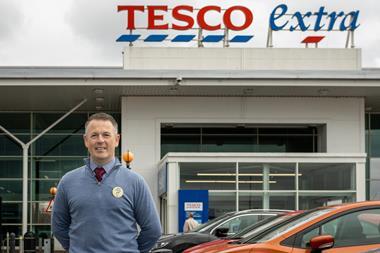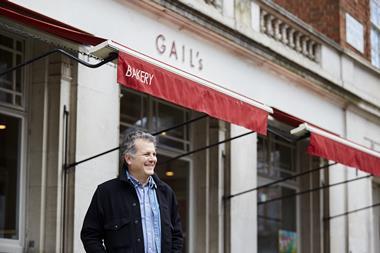Jonathan Hart has his work cut out at beleaguered confectioner Thorntons. But he’s confident that more supermarket listings…and dog-shaped chocolates will help him turn around his fortunes
Thorntons was once described as the Coventry City of confectionery because of the company’s high turnover of managers - so Jonathan Hart must be feeling the heat at the moment. Since he left Caffè Nero to take the reins at the struggling confectioner in January 2011, he has had to contend with 63% slump in profits before tax to £3.1m in the 28 weeks to 7 January 2012, an 80% fall in the share price and a grandson of the founder accusing management of “wrecking” the 100-year-old company.
To compound the misery, Christmas sales were poor and it continues to struggle with the problem of its supermarket sales cannibalising those through its own stores. The last thing it needed was the collapse of Clinton Cards last month (‘Thorntons hit by closures at Clinton Cards,’26 May).
Yet while Hart has admitted that the company needs to close a significant number of stores over the next few years if it’s to survive, he remains suprisingly upbeat about the company’s prospects - perhaps because slashing the store count is not the only drastic action he is planning to take to revive its flagging fortunes.
One of his first moves on becoming CEO 18 months ago was to order a review of the company’s estate to establish why some of its stores were performing so badly. The answer was simple.
“We were behaving too much like mini supermarkets,” he says frankly, adding that the offer was also blighted by bland merchandising and the poor state of the company’s property estate, which had suffered from under-investment.
snapshot
Name: Jonathan Hart
Age: 51
Lives: Hertford, Herefordshire
Family: Married with two children (21 and 18)
Favourite Thorntons chocolate: Belgian White Chocolate Block
Career: Joined Thorntons in January 2011 from Caffè Nero where he was MD for five years. He has 25 years of experience in retail working for a diverse group of companies including Abbey, Woolworths, PC World and Dixons
Hart readily admits that Thorntons had “not been aspirational enough,” but he rebuffs suggestions that the company should have become more like the thriving high street confectionery chain Hotel Chocolat. “People talk about us as if we were once like Hotel Chocolat or Godiva, but our roots are with steelworkers in Sheffield,” he says adamantly. “We have to remember our core mission, which is to offer an affordable treat to the average earner.”
Faced with an estate in dire need of refurbishment and a number of failing stores, Hart announced last June that he would take advantage of lease breaks to close 120 stores over the next three years and consider shutting a further 60 over the same period. Ultimately, the aim is to have an estate of between 180 and 200 stores “in sustainable locations”, he says. “The stores should be the showcase for the brand - retail should be the best marketing vehicle for the brand.”
To this end the company revamped a store in Birmingham towards the end of last year that will provide a blueprint for Thorntons stores of the future. The confectioner has opted for a more upmarket, theatrical feel. Products have been taken off the shelves and placed onto tables, there is a larger serving counter and the colour scheme now features more purple and darker browns. “We need to persuade people to consider Thorntons at times of the year other than Easter and Christmas,” says Hart.
So far, sales at the Birmingham store have been encouraging, according to Hart, who plans to fine-tune the concept over the summer before commencing the refurbishment of 75 stores over the next three years.
Ahead of the refurb programme, the company has also introduced changes across its existing estate to encourage off-season gifting. More box chocolates are being displayed outside their boxes and new products have been developed, such as dog-shaped chocolates to give dog owners a novel way of thanking neighbours for looking after their pet. The plan is that these in-store exclusives will differentiate the company’s offer from the range stocked by the multiples.
Since the company ramped up its supermarket presence in 2006 having entered the market a few years earlier, it has risen to 71st in The Grocer’s Britain’s 150 Biggest Brands list after sales growth of 9.1% [Nielsen MAT 24 December 2011].
However, sales through the supermarkets are lower margin than those through its stores and so the decline of own-store sales has done disproportionate damage to the company’s profits. Profits slumped from £8.4m to £3.1m in the six months to 7 January on sales down 2.6%. Even so, Hart rejects suggestions that the move into the mults has backfired.
“You have to present your products where the consumer wants to buy them,” he argues. “If Thorntons hadn’t gone into the supermarkets, people would have bought milk Tray there instead.”
Indeed Hart sees what he calls “the commercial channel” of the company’s business becoming the dominant arm, worth more than 50% of sales (up from the current 40%), as it secures a larger chunk of supermarket chocolate sales at Christmas and Easter and enters more c-stores. He also has a plan to shore up lower supermarket margins. “We need to create a promotional strategy next Christmas to support margins - by not promoting our premium collection enough last year, we didn’t get the right balance,” he says.
Hart and his team still have much to do to avoid the dreaded vote of confidence. But there are already signs that this new strategy is working, with better than expected trading at Easter bringing some much-needed cheer to the beleaguered business.



















No comments yet